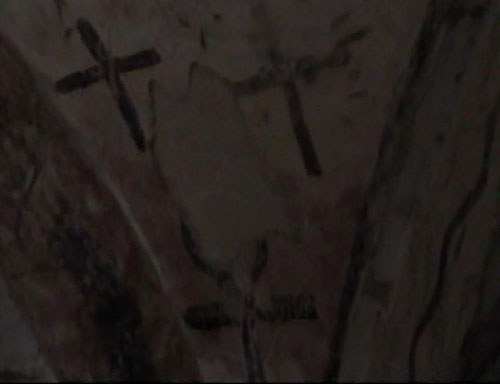We are pleased and honored to welcome Thomas Brophy as March Author of the Month. Please join the discussion on the AoM Message Board and discover much more about Thomas’s new book The Christmas Code – A New Astronomy of Christmas and how it came from Egypt, in which a little known Newtonian study of the original dating of Christmas is revealed, and Brophy continues to connect the dots, back through time, to who the “magi” in the Bible story really were.
I decided to start this essay with a review of The Christmas Code, by my long time friend and colleague Paul Rosen. Related scientific articles that Paul and I have authored together include, Satellite Imagery Measures of the Astronomically Aligned Megaliths at Nabta Playa, Brophy, T.G. and Rosen, P.A., Mediterranean Archaeology and Archaeometry Journal, 2005, and a conference proceeding report Paul presented at TerraSAR X Science Team Meeting, Feb. 2008, Stuttgart, Germany, TerraSAR-X Spotlight Interferometric Observations of Archaeoastronomical Structures at Nabta Playa, Egypt.
Paul’s review may be of special interest to this audience because, in addition to comments about this specific book, he includes some interesting perspectives on alternative or non-conventional scholarship in general, which is of particular interest at grahamhancock.com. Originally a personal email to me, Paul has given permission to publish this as a review of The Christmas Code. I am working on a revised edition of The Christmas Code, incorporating many of Paul’s points, to be published soon. I hope his review, of the first edition, may stimulate some topics for this month’s discussions.
Review of “The Christmas Code” by Paul Rosen:
I ended up reading it all on my iphone kindle reader. It is a very enjoyable and entertaining read, plausibly argued, and as usual peppered with Brophyisms that I would have recommended leaving out – but more on that below! …
Other than the formatting issues (small screen so a lot of strange page breaks) the e-reader worked fine. I also took notes along the way, which is a nice convenience. There is no way to send them to you directly from the kindle app, so at the end of this email they are listed as transcribed. Is it possible to edit the electronic file for instantaneous update, or do you need to follow the usual conventions of publishing a new edition or an errata sheet?
In general, and in regard to the jabs at conventional scholarship in particular, I think you do the work and yourself a disservice by allowing yourself the indulgence of criticism. It does no good to anyone to criticize academics or compare your work to theirs, unless your specific aim is to differentiate your work from theirs. It does succeed in doing that, but primarily at your expense I would say. For example, you do a really nice job of avoiding the issue of divinity in your interpretation of the Christmas star story… until you bash the rationalists for something you speculate that they would feel! Why not let the work speak for itself? It does! The whole notion of taking the gospel of Matthew literally, interpreting specific words contextually (e.g. the intent of secrecy in the secret magi meeting), and weaving a self-consistent historio-astronomical thesis from it causes any reader to ponder questions in a new way from their perspective, be they rationalists, pre-rationalists, or integralists. Pre-rationalists could use it as further proof of the nativity tale. Rationalists could pick apart the plausibilities of the arguments (such as how easy it is to prophesy things when writing after the fact), and integralists may, well, I don’t think I’m there yet, so I’m not sure what they would make of it, other than possibly some grand connection to the cosmos. All it needs is more complete referencing and follow-through on arguments, and less griping about how conventional academics demand proof for assertions before accepting them (which I think is actually a reasonable way to differentiate what we believe we know to have been the case from what we suspect may have been the case but are less sure about).
A great book I read that you may enjoy is "Why the West Rules – for Now" by a classicist and archaeologist named Ian Morris. It is a sweeping history of civilization that attempts to use metrics to quantify power centers throughout the ages and why they were as they were. I’m not sure I buy all his arguments, but because he deals with ancient history with scant evidence of assertions, you may find it interesting to read how he, an established and accepted academic, can make statements that are speculative but not get pilloried for it by colleagues. He does it by a combination of comprehensiveness in his research – following all threads as far as possible and exposing all sides of an issue – and by publishing the less speculative stuff in academic journals to build street cred.
Anyway, a fun essay, and I look forward to its expansion, and other works! Congratulations again.
cheers,
Paul
Excerpts from The Christmas Code: A New Astronomy of Christmas and how it came from Ancient Egypt
From the Introduction:
Jesus was born on a spinning, wobbling planet, hurtling through the Orion Arm of our Milky Way galaxy, whirling around the Sun. Freeze-frame that planetary journey at the instant of Jesus’ birth. The orientation of Earth to Sun to stars to galaxy define the date we call “Christmas Day”.
The Date of Christmas
Why is Christmas the time of year that it is? Sir Isaac Newton (1642-1727), father of modern science who was also obsessed with theology, turned his tremendous scholarly skills to investigate that question and he found that the early Church leaders fixed Christmas Day to be the southern solstice (winter solstice in our northern hemisphere) such that Jesus’ cosmic conception was nine months earlier on the day of spring equinox. Winter solstice is the day of the year when earth’s spin axis, north pole, points closest toward the Sun, the shortest day of the year. Solstice is also associated with the birth of our new year, although our modern calendar slipped during the early centuries of its inception away from astronomical precision. The earliest Christians, before any large scale institutionalization of the Church, Newton and other investigative scholars tell us, were not very concerned with the specific date of Jesus’ birth – they were concerned with the living essence of the teachings of the faith, and any related astro-symbology was probably an ingrained part of their daily lives and rituals. It was with the organization of the institution of the Church that it was realized a specific date for Jesus’ birth was needed for the general public to celebrate. And they identified the very ancient symbology of solstice, for the Christmas birth and equinox for the Christ inception.
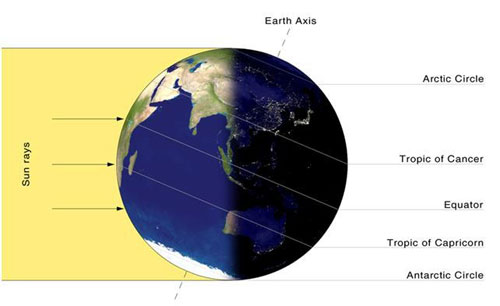
[Figure 1. Orientation of the Earth on the southern solstice, “winter solstice”.]
Newton also found that the birth of John the Baptist (who baptized Jesus) was fixed to the summer solstice and so his conception to the fall equinox. As Newton wrote,
“The times of the Birth and Passion of Christ, with such like niceties, being not material to religion, were little regarded by the Christians of the first age. They who began first to celebrate them, placed them in the cardinal periods of the year; as the annunciation of the Virgin Mary, on the 25th of March, which when Julius Cæsar corrected the Calendar was the vernal Equinox; the feast of John Baptist on the 24th of June, which was the summer Solstice; the feast of St. Michael on Sept. 29, which was the autumnal Equinox; and the birth of Christ on the winter Solstice, Decemb.25…” [Newton, Isaac, Observations on the Prophecies of Daniel, and the Apocalypse of St. John, Chapter XI: Of the Times of the Birth and Passion of Christ, published posthumously, 1733.]
Thus the generative dates of the two most important figures in the origin of Christianity were fixed to the four cardinal points, symbolically forming a cosmic cross – the symbol of Christian faith….
…Curiously, Newton himself was born on December 25, 1642, according to the Julian Calendar which was still in use at the time…
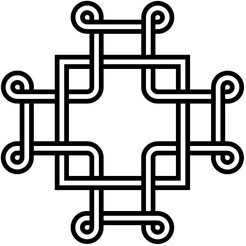
[Figure 2d. Macedonian Cross.]
The Macedonian Cross, symbol of Macedonian Orthodox Christianity, employs Solar Cross imagery and is curiously the same as the ancient Solar Cross of the Ohio mound building peoples.
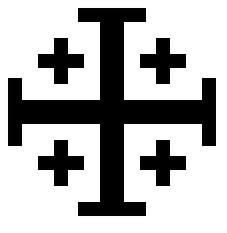
[Figure 2e. Jerusalem Cross.]
Popular during the Crusades, the Jerusalem Cross surely had ancient origins. The four smaller crosses can represent the four seasons – the four stations of the Sun. And the four smaller crosses can represent the role of the cross in the early development of mathematics, geometry, and astronomy (see later discussion of Higgins, 1912).
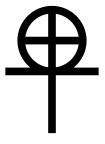
[Figure 2f. Coptic Christian Cross.]
The Copts, Egyptian Christians, probably among the earliest organized Christians, adopted the very ancient Egyptian Ankh Cross symbol of universal life spirit, with the addition of a Solar Cross in the center of the loop on to of the original Ankh Cross. This is also called a Gnostic Cross.
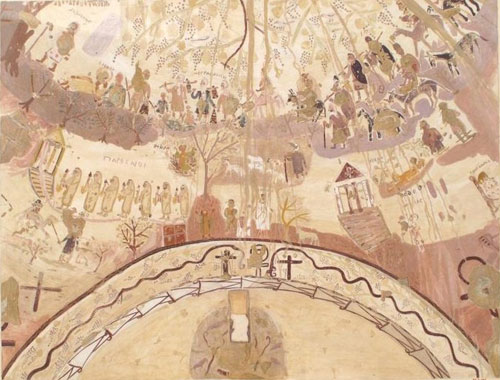
Click for larger image
[Figure 2g. Ankh Crosses and simple Crosses together at El Bagawat early Christian necropolis.]
I first visited the western oases (Baharia, Farafra, Dakhla, Kharga) of Egypt in 2003. …
…[The El Bagawat necropolis contains] numerous Biblical scenes (Old and New Testament) often sharing pre-Christian Egyptian elements, including paintings of Jesus and Mary surrounded by zodiac images. …
The Year of Christmas
So we celebrate Christmas at this particular time of year, the winter solstice, for a combination of solar-astronomical plus ancient religio-symbolic reasons. But then why do we fix this cosmic-human event to 2,012 years ago [at time of this writing], the start of the “Common Era” at 1 CE? Could that, the designation of the year to start the Common Era of Christ, also have been determined according to a combination of astronomical plus ancient religio-symbolic reasons? We now know that the earliest Christians semi-secretly used the sign of the fish, in Greek the Ichthys, which is actually still used to signify Christian faith today. To an astronomer that suggests an obvious connection. Circa 1 CE (or roughly 6 BCE the probable birth year of Jesus) was also the beginning of the zodiac age Pisces which is designated by the symbol of a fish (often two fishes). Thus esoteric Christian groups today say the fish symbol was used by the followers of Jesus because he was the Avatar for the Age of Pisces. Indeed, esotericists say, Christ timed his dramatic entry into human affairs to coincide with the start of the Age of Pisces. …

[Figure 3. The Ichthys fish, symbol of early Christians.]
The Star in the East
The popular imagery associated with any Jesus nativity scene always includes a “Christmas Star” of some sort, which somehow heralded or guided the birth of Christ. Sometimes the star is the central feature of the whole scene.
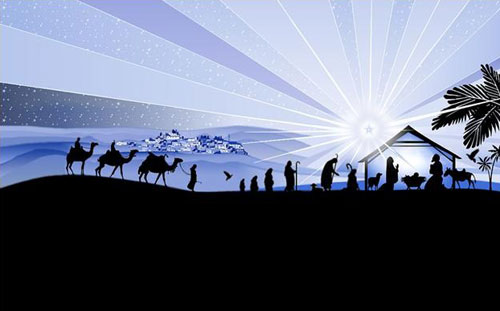
[Figure 5. Typical nativity scene featuring a Christmas Star, image from vectorwallpapers.net.]
But where does this belief about an important star signaling the nativity come from? The nativity star is a central trope of the Bible gospel story of Matthew chapter 2.
…So the whole notion of an important “star in the east” heralding the nativity was introduced by some group called “Magi from the east” when they went to Jerusalem and started talking publicly about it. Apparently the people of Jerusalem, including the great and powerful King Herod and his chief scholars and priests, were clueless about the existence of such a star or its importance until these guys, the Magi, came to tell them about it. And something about these Magi frightened the daylights out of Herod and, according to Matthew, all of Jerusalem.
Who were the Magi?
In the original Greek, “Magi” was written as “Magoi”. Magoi transliterated to “Magi” in English tends to be interpreted something like “wise men”, or “magicians”. A Greek Grammar says the Magi (whom I will call Magoi in this essay) was “the name given by the Babylonians, Medes, Persians, and others, to the wise men, teachers, priests, physicians, astrologers, seers, interpreters of dreams, augers, soothsayers, sorcerers etc.” But what can modern historical methods tell us about the actuality of who the Magoi in Matthew’s nativity story really were? …Spanning much of the overland portion of the lucrative Silk Road, the Parthians had a powerful military, with cavalry that were known for defeating even the mighty Roman army with whom they had regular border squabbles.
… even if there were three, or twelve, leaders of the Magoi they likely had a large number of support staff, porters, caravan specialists, liverymen, and likely some skilled military cavalrymen with all their supporting staff and equipment. And the Magoi were the very individuals who held the authority to appoint new kings in mighty Persia and the Middle East, bursting there into Jerusalem asking about a new baby king. No wonder they gave King Herod the willies!
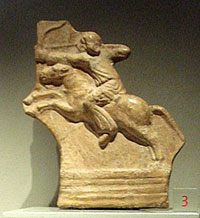
Click for larger image
[Figure 6. Relief of a Parthian cavalryman, Palazzo Madama museum, Turin, Italy.]
The Magoi’s Star of Time, Pisces
Matthew says that the Magoi arrived after the birth of Jesus, and they were asking around for the baby’s whereabouts. So it is clear the Magoi had only a rough idea of the location of Jesus’ birth but they believed they had accurate knowledge of the time of Jesus’ birth. This is also made clear, further on in the gospel account, in Matthew verses 2:5-6…
…So the question arises, where did the Magoi get the star-knowledge about the time of the birth, in the first place? Before we track that question down, though, what happens next in Matthew’s gospel story is very interesting…
Matthew 2:8-9 “[Herod] sent them to Bethlehem, and said, “Go and search diligently for the young child. When you have found him, bring me word, so that I also may come and worship him.” They [Magoi], having heard the king, went their way; and behold, the star, which they saw in the east, went before them, until it came and stood [stopped] over where the young child was.”
…This is the third time, in this chapter of Matthew, that mention of “star” appears. …In any case, the context of Matthew 2:9 suggests a very plausible, and simple interpretation for this stellar event that the Magoi were following.
Remember what the Magoi were doing at the time. …
And that night on the road from Jerusalem to Bethlehem, directly south and, depending on the time of night of their travel, in fact following their bearing as they went, they had an excellent view of Crux the Southern Cross directly in front of them.
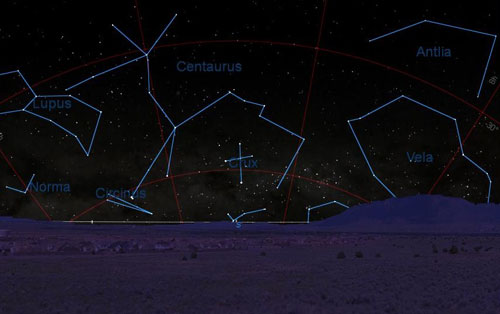
Click for larger image
[Figure 8a. Stellar cross of the Magi. Crux on the southern meridian, 5:40 AM, winter solstice, 5 BCE, as seen from the road to Bethlehem, image from StarryNightPro.]
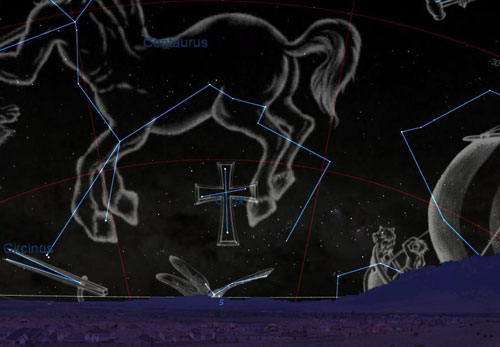
Click for larger image
[Figure 8b. Stellar cross of the Magi. Crux on the southern meridian, 5:40 AM, winter solstice, 5 BCE, as seen from the road to Bethlehem, with constellation illustrations from StarryNightPro.]
…If that is the case, then where did the Magoi get that knowledge from?…
Daniel, Chief of the Magoi
Many Christians believe the nativity of Jesus was prophesied in earlier books of the Bible, in the Old Testament, especially the Book of Daniel which also highlights the role of the Magoi. The book begins with Daniel, a Magoi, being taken to Babylon circa 600 BCE when it was ruled by Nebuchadnezzar (who is an actual historical figure, and Daniel probably was too). Nebuchadnezzar had some crazy disturbing dreams that he was desperate to have interpreted for him. His priestly advisors, other Magoi, failed to satisfy Nebuchadnezzar’s need for interpretations and so he ordered them all put to death. But Daniel was summoned, met with Nebuchadnezzar and managed to interpret the dreams satisfactorily for Nebuchadnezzar. So the Magoi were spared, and Daniel was named “Rab-mag” chief of the Magoi and governor of Babylon. …
…OK, if so, where did Daniel get that astronomical knowledge from in the first place?…
Conquests of Egypt
The ever expansive Nebuchadnezzar’s first campaign into Egypt was a failed attempted invasion in 601 BCE, during his early thirties. Some 33 years later, a Nebuchadnezzar much more powerful after a long successful siege of Tyre, and now with Daniel as chief Magoi scholar-priest of his court, mounted another campaign into Egypt. Little is concretely known to history about the results of that campaign. But the Book of Ezekiel [29:18-20; 30:10-20] says that Nebuchadnezzar “received the wealth of Egypt” as payment for executing God’s judgment against Tyre.
If king Nebuchadnezzar received the material-wealth of Egypt, did his chief Magoi-priest Daniel receive some important knowledge-wealth of Egypt, including the astronomical time keeping method that could prophecy the arrival of the Jewish Messiah?…
Knowledge of Stellar Precession in Ancient Egypt
The best physical evidence, anywhere in the world, that ancient peoples earlier than Greeks such as Hipparchus knew about precession of the equinoxes (and precession of all stars) comes from ancient Egypt. In our book Black Genesis: The Prehistoric Origins of Ancient Egypt Robert Bauval and I review just some of the Egyptian temples that were repeatedly rebuilt over the centuries, each time shifting the axis of the temple building so as to align with the direction to rising of a star (often Sirius) as it moves through precession. …
…Now if we consider the central location within Egypt where such advanced knowledge of astronomy, mathematics, architecture, and medicine was likely to be kept, that will link us back again to our gospel story of Matthew.
Heliopolis, University of the Ancient World
About 13 miles northeast of the Great Pyramids of Giza, in Pharaonic Egyptian times, stood the pinnacle of higher learning of Egypt, and in fact of the whole ancient world of the time – Heliopolis. From Old Kingdom times, and probably before, and on into New Kingdom times Heliopolis was the center of Astronomy, Geometry, Medicine, History, and Philosophy. The high priests of Heliopolis were called “Chief of Observers” or “Greatest of Seers”. Into the time of ancient early classical Greece, all the great scholars and thinkers visited Heliopolis to study, or if they couldn’t visit they wanted to. According to the ancient Greeks, no less than the likes of Homer (8th century BCE), Solon (circa 600 BCE), Pythagoras (circa 540 BCE), Plato, Solon’s distant descendant (circa 400 BCE) all frequented Heliopolis, as adult students! Plato’s young student, the Greek astronomer Eudoxus of Cnidus received a scholarship to support him for 16 months of study in Heliopolis, where the Heliopolitan priest Ichonuphys taught him the exact length of the solar year (as Strabo described), for which discovery Eudoxus himself was later credited. …
…Was the constellation Pisces the fish(es) known to the Magoi? …Recent work on the Babylonian cuneiform star catalog Mul.Apin dated to circa 1000 BCE … appears to definitively prove the Babylonians named the eastern part of the constellation Pisces, Anunitu (”fish”), and referred to it as “Fish Goddess/Childbirth Goddess”.
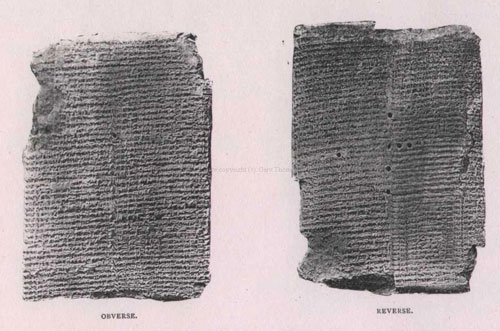
Click for larger image
[Figure 10. Babylonian cuneiform Mul.Apin star catalog, ca 1000 BCE, British Museum, London.]
The constellation Pisces is clearly indicated on the famous Denderah Zodiac.
…If the links described so far, of ancient Egyptian zodiac and solar time keeping to the birth of Christ are not convincing enough, consider that it is the centerpiece of the magnificent Saint Peter’s Square of the Vatican itself. The first thing visitors to the Vatican entry area, Saint Peter’s Square, notice is that at its center is a gigantic pink granite Egyptian obelisk. The Vatican Obelisk was originally erected in Heliopolis circa 2400 BCE by a Fifth Dynasty Egyptian pharaoh. There it remained until 30 BCE when Augustus, the first Emperor of Rome in one of his first acts upon annexing Egypt from Ptolemaic Greece, ordered the obelisk moved from Heliopolis some 115 miles to the Forum in Alexandra. Sixty six years later, 37 CE, Caligula had the giant obelisk shipped across the Mediterranean Sea to Rome where it was erected the centerpiece of the Circus Nero, oriented to cast its shadow on winter solstice sunrise the length of the circus all of which was oriented along the solstice line. Finally in 1586, Domenico Fontana moved the obelisk to the Vatican where Bernini made it the centerpiece of his magnificent design of Saint Peter’s Square. …
…At this point it is instructive to pick up where we left off in the nativity story of Matthew 2:11-14. … If I may paraphrase Matthew: the Magoi were not stupid, they knew Herod didn’t ask them to tell him where the child was so “he could worship him”. So the Magoi accomplished their mission, gave their gifts to the Holy Family, and sneaked back to Parthia by a different route to avoid the forces Herod was sure to have looking for them. Probably the Magoi also told the Holy Family (and maybe God did too) to get the heck out of there and to flee to Egypt because Herod wanted to kill them. So the Holy Family used the money (gold) and valuable gifts from the Magoi to finance their escape to Egypt.
But Matthew does not say where in Egypt the Holy Family went to.
Where in Egypt did the Holy Family go?
You guessed it, Heliopolis! …
Summary
The day of Christmas was set to winter solstice by the early Church authorities, to coincide with the cosmic beliefs of the early Christians and also for the political purpose of synchronizing with already existing holidays. The origin year of Christmas coincides with the Magi prediction of, and observational measurement of, the zodiacal precession of the equinox into Pisces. This Christmas star of time is described in Matthew 2:2 and 2:7. The Magi on the road to Bethlehem then verified their observation as they were following Crux the Southern Cross, the Christmas star of place, which went before them over Bethlehem. This is described in Matthew 2:9 and 2:10. And from the time of Daniel up to the time of nativity of Jesus, the Magi maintained the knowledge of how to measure that event, which they got from very ancient sources in Heliopolis, Egypt.
Finally, astute readers will have noticed that my story about the astronomy of the Christmas star has been Divinity-neutral. That is, although I give a naturalistic explanation for the stars in Matthew’s gospel story, this essay says nothing that should diminish religious faith. Rationalist-materialists may be disappointed that I do not use my training in astrophysics as a platform from which to bash the spiritually oriented. But physics is a science that exquisitely measures external material reality. I find nothing in modern physics that should deny the presence, or absence, of divinity in the internal spiritual aspects of reality. The two, inner and outer, are but sides of the single coin that is cosmic reality.
Biography
Thomas Brophy has a Ph.D. in physics from the University of Colorado, was a staff research scientist at the Laboratory for Atmospheric and Space Physics, Boulder, with NASA interplanetary spacecraft projects, and was a National Science Foundation exchange scientist with the University of Tokyo and Japan Space Program. His work focused on planetary astrophysics problems. A member of one of the Voyager II spacecraft instrument teams, he developed theoretical understandings for data from the outer planets (Jupiter, Saturn, Uranus, Neptune), and was involved in defining science goals for space mission instrumentation. Those interests in fundamental theory, and teaching at the University level, led him to broader studies involving the non-calculable and immeasurable aspects of the universe, and to Integral philosophy. These Integral studies, together with practice of contemplative/yogic traditions, led to his book The Mechanism Demands a Mysticism, and subsequent publications, and invited presentations on Integral theory and psychospiritual growth. He is former Dean of the California Institute for Human Science, a graduate school and research center dedicated to integrating the pyschospiritual and scientific worldviews, where he is now a professor and Integral Sciences Consultant. Recombining Integral philosophy with astrophysical dynamics led to his studies of the astro-archaeology of pre-history and proto-historic Egypt, and investigations into the origin of the Zodiac, and “Zodiac Ages” in early human cultures, and his book The Origin Map. His book Black Genesis: The Prehistoric Origins of Ancient Egypt about the origins of the pharaohs from a mysterious star-ceremonialist African peoples, is co-authored with Robert Bauval. His book Imhotep the African: Architect of the Cosmos also co-authored with Robert Bauval is due to be published Fall 2013. He has also worked in the IT/telecommunications industry, and found application for fundamental dynamics calculation methods in gaming and investment theory. He has published peer reviewed scientific articles in premier journals including Icarus, Mediterranean Journal of Archaeology and Archaeometry, IEEE Journal, Science, and his work was reported on in Nature magazine. He has been a featured presenter at numerous scientific conferences, and invited plenary speaker at Integral spirituality meetings, in the United States, Europe, Japan and New Zealand.
website: http://www.thomasgbrophy.com/







